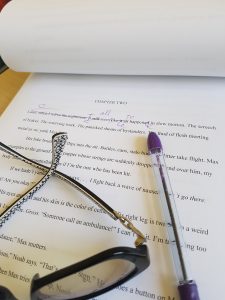 For writers who don’t write quickly, it can be hard to justify taking a break. Instead, we often push ourselves to write more, while mentally beating ourselves up for not being as prolific as we’d like. However, the research is clear: taking a break from what we’re working on can actually improve productivity. A new and growing body of research outlined in the New York Times shows that strategic renewal – daytime workouts, coffee breaks, time away from the office and longer, more frequent vacations – boosts productivity, job performance and health.
For writers who don’t write quickly, it can be hard to justify taking a break. Instead, we often push ourselves to write more, while mentally beating ourselves up for not being as prolific as we’d like. However, the research is clear: taking a break from what we’re working on can actually improve productivity. A new and growing body of research outlined in the New York Times shows that strategic renewal – daytime workouts, coffee breaks, time away from the office and longer, more frequent vacations – boosts productivity, job performance and health.
Many writers rely on the routine of a daily walk. Stephen King gets in about four miles a day; Charles Dickens logged about three hours every afternoon. Walking leads to more creative thinking than sitting does. Researchers from Stanford University found it boosted creative output by 60 percent. That’s significant. We walk Team Sheltie once or twice a day and I look forward to the break. It often sparks story ideas or helps with my work in progress.
But a walk is just a walk. And unless you cycle or drive to a new destination every day, the same old walking routine can become stale fast.
That’s where the artist’s date comes in. I’m sure you’ve heard of it. The brainchild of Julia Cameron, the artist’s date is a weekly solo expedition to explore something that interests you. It need not be overly ‘artistic.’ Cameron says it’s more ‘mischief than mastery.’ It’s meant to fire up the imagination and spark whimsy.
To be worthwhile, an artist date must happen every week and it must be taken alone. No friends, spouses, children allowed. It should involve leaving the house. What about being housebound because of bad weather, you ask. Cameron believes that an occasional in-house date if you’re alone and devoting yourself to something that ‘fills the well’ is acceptable but the goal is an excursion out of the house. Essentially, it’s a two-hour play date where you indulge your inner child.
It doesn’t have to cost anything, other than time. Some ideas:
Visit a shop that has nothing to do with what you actually do – an art supply store, a music store, a fabric, bead or (my favorite) a yarn shop.
Visit a U-pick farm.
Go to a graveyard and read the tombstones (it sounds morbid but this is great for writers who want story ideas).
Explore a neighboring town, or a part of your town you aren’t familiar with.
Take a hike.
Walk around town and take pictures of what inspires you.
Watch the birds.
Go to Home Depot with $5 in your pocket. See what cool things you can find to create an art project with five bucks. Go crazy.
Visit a plant nursery and plan your perfect garden.
Go to the library and find a book on a subject you know nothing about. Check it out.
Spend some time at a furniture auction.
Go for a bike ride.
Listen to live music.
Take yourself out for afternoon tea and people watch.
Visit a rock hound shop.
See a movie that appeals to you.
Go to a museum.
Watch a sunset.
Visit a farmer’s market.
And my personal favorite: walk on the beach and watch the waves crashing on shore.
 I received a lot of feedback on last week’s blog post about writing slowly. Most people who reached out seemed rather regretful that they don’t write faster. While it’s true that writing quickly can sharpen our skills and lead to more published books, the most important thing is consistent productivity, whether you write slowly or quickly.
I received a lot of feedback on last week’s blog post about writing slowly. Most people who reached out seemed rather regretful that they don’t write faster. While it’s true that writing quickly can sharpen our skills and lead to more published books, the most important thing is consistent productivity, whether you write slowly or quickly. It’s NaNoWriMo, or national novel writing month. For those who don’t know, NaNoWriMo participants attempt to write a 50,000-word manuscript between November 1 and November 30. There are many support groups on line with members offering encouragement and holding each other accountable. NaNoWriMo is a great way to immerse yourself in a project, boost your writing output and end the month with a sense of accomplishment.
It’s NaNoWriMo, or national novel writing month. For those who don’t know, NaNoWriMo participants attempt to write a 50,000-word manuscript between November 1 and November 30. There are many support groups on line with members offering encouragement and holding each other accountable. NaNoWriMo is a great way to immerse yourself in a project, boost your writing output and end the month with a sense of accomplishment. It’s nearly the end of October. Yesterday’s torrential rain sent gusts of leaves falling from the trees. Good thing the garden has been put to bed for the winter because it’s the kind of weather that doesn’t encourage outside lingering. Luckily, I have some great books to keep me company when the rain is falling. Here’s what I’m reading this week:
It’s nearly the end of October. Yesterday’s torrential rain sent gusts of leaves falling from the trees. Good thing the garden has been put to bed for the winter because it’s the kind of weather that doesn’t encourage outside lingering. Luckily, I have some great books to keep me company when the rain is falling. Here’s what I’m reading this week: Just as a fictional character can make a book shine, it’s the people we care about who bring the heart and love and emotion to our lives.
Just as a fictional character can make a book shine, it’s the people we care about who bring the heart and love and emotion to our lives. October is National Bullying Awareness Month. Given that the first month of school is behind us and routines have been established, for kids who are victims of school yard bullying that means the bullying pattern is probably underway by now too. Books can’t eliminate bullying – I know that – but a good story may provide enlightenment to bullies themselves, as well as bystanders caught up in peer pressure. Equally important, victims often benefit from stories, gleaning insights, coping strategies and much-needed comfort and support. Here are some books on bullying for young and not-so-young readers.
October is National Bullying Awareness Month. Given that the first month of school is behind us and routines have been established, for kids who are victims of school yard bullying that means the bullying pattern is probably underway by now too. Books can’t eliminate bullying – I know that – but a good story may provide enlightenment to bullies themselves, as well as bystanders caught up in peer pressure. Equally important, victims often benefit from stories, gleaning insights, coping strategies and much-needed comfort and support. Here are some books on bullying for young and not-so-young readers. Last week, I finished doing a substantive revision on No Right Thing. Revising, as I’ve said before, is one of my favorite parts of the writing process. Polishing and tweaking can take a story from good to great, and I think No Right Thing is one of the best YA novels I’ve written so far. A big shout out to Melanie Jeffs at Crwth Press for comments and suggestions that gave me the springboard I needed to dive in and make some changes.
Last week, I finished doing a substantive revision on No Right Thing. Revising, as I’ve said before, is one of my favorite parts of the writing process. Polishing and tweaking can take a story from good to great, and I think No Right Thing is one of the best YA novels I’ve written so far. A big shout out to Melanie Jeffs at Crwth Press for comments and suggestions that gave me the springboard I needed to dive in and make some changes.
 Here it is nearly the end of August; September is right around the corner. Soon school will be back in session, routines will be more in force and I’ll be back to blogging every week. For now, we’re still settling into our new home and getting used to the house and the neighborhood. As well as welcoming rabbits, squirrels, dear and raccoon to our yard, we have a family of quail that stops by fairly often. Mom (or maybe Dad) stands guard on a fence post while the rest of the family scurries along the ground. Fortunately, Team Sheltie has yet to see the quail parade. We might build a quail house next year. It’s on the list. Right now though, I’m busy revising No Right Thing, doing some freelance editing jobs and organizing my office. Oh, and finding a few minutes here and there to read. Here’s what I’m reading this month:
Here it is nearly the end of August; September is right around the corner. Soon school will be back in session, routines will be more in force and I’ll be back to blogging every week. For now, we’re still settling into our new home and getting used to the house and the neighborhood. As well as welcoming rabbits, squirrels, dear and raccoon to our yard, we have a family of quail that stops by fairly often. Mom (or maybe Dad) stands guard on a fence post while the rest of the family scurries along the ground. Fortunately, Team Sheltie has yet to see the quail parade. We might build a quail house next year. It’s on the list. Right now though, I’m busy revising No Right Thing, doing some freelance editing jobs and organizing my office. Oh, and finding a few minutes here and there to read. Here’s what I’m reading this month: Two exciting things happened last week. We moved into our new home and I signed a YA book contract with Crwth Press. Talk about a fresh start filled with wonderful possibilities.
Two exciting things happened last week. We moved into our new home and I signed a YA book contract with Crwth Press. Talk about a fresh start filled with wonderful possibilities.
 In a few short days, we’ll be moving from a cottage by the sea to a house with a garden. Though we’ve enjoyed our rocky shoreline view of eagles and herons and sea lions, it’s been seven months of uncertainty, of feeling deeply unmoored.
In a few short days, we’ll be moving from a cottage by the sea to a house with a garden. Though we’ve enjoyed our rocky shoreline view of eagles and herons and sea lions, it’s been seven months of uncertainty, of feeling deeply unmoored.
Comments